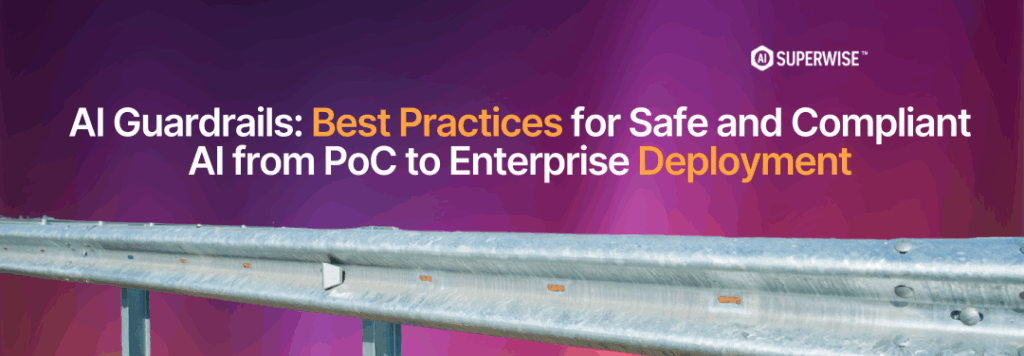Why AI Guardrails Are Critical Across AI Lifecycles
As organizations increasingly embed AI into business operations, the need for robust AI guardrails is more urgent than ever. Whether you’re a data engineer testing a proof of concept (PoC) or an enterprise deploying agentic AI across multiple domains, these safeguards ensure AI systems operate safely, ethically, and in compliance with regulations.

Consider these examples:
• Manufacturing: AI-powered robotic assembly lines can increase efficiency, but without operational safeguards, they may exceed safe limits, causing equipment damage or safety hazards. Guardrails ensure AI respects operational thresholds and emergency protocols.
• Healthcare: AI diagnostic tools can assist in analyzing patient scans, but without governance measures, they may misclassify rare conditions or introduce bias. Proper guardrails enforce accuracy, ethical decision-making, and regulatory compliance, protecting patient safety.
These cases illustrate why embedding AI guardrails early, from PoC testing to enterprise-wide deployment, is essential to prevent costly errors, maintain trust, and comply with industry standards.
What Are AI Guardrails?
AI guardrails are structured safeguards, operational controls, and governance measures that ensure AI systems stay within defined boundaries. They prevent harmful outputs, protect sensitive data, and uphold regulatory and ethical standards. From initial development to full-scale deployment, these frameworks are crucial for safe, reliable, and scalable AI operations.
For Data Engineers: Implementing Guardrails in PoCs
Integrating guardrails early in AI experimentation is critical. Here’s how data engineers can safeguard PoCs effectively:
• Data Privacy and Protection: Remove personally identifiable information (PII) and anonymize datasets to prevent leaks. Verify effectiveness: Test queries and audit logs to confirm that sensitive data is never exposed.
• Bias Detection and Mitigation: Identify potential biases in training data to ensure equitable AI outputs. Verify effectiveness: Compare model predictions across demographics to detect skewed results.
• Output Filtering: Deploy filters to block inappropriate or harmful content generated by AI models. Verify effectiveness: Simulate edge-case scenarios and monitor outputs to confirm that inappropriate content is flagged or blocked.
• Access and Permission Controls: Restrict access to models and datasets to authorized personnel. Verify effectiveness: Review access logs and test permissions periodically to ensure enforcement.
By embedding these technical and operational safeguards into PoCs and continuously testing them, data engineers can identify risks early and ensure AI behaves safely before scaling to enterprise deployments.
For Enterprises: Scaling AI with Robust Guardrails
Enterprise-scale AI deployment introduces additional complexity. Effective strategies include:
• Policy and Governance Enforcement: Define policies governing AI behavior and ensure alignment with ethical and regulatory standards. Verify effectiveness: Conduct audits across departments and use automated compliance checks.
• Continuous Monitoring and Oversight: Track AI outputs in real time to detect anomalies or unsafe behaviors. Verify effectiveness: Use dashboards, alerting systems, and anomaly detection to ensure AI operates within expected thresholds.
• Audit Trails and Transparency Measures: Maintain detailed logs of AI interactions and decisions. Verify effectiveness: Review logs regularly to confirm traceability, reproducibility, and regulatory compliance.
• Cross-Functional Collaboration: Engage data scientists, IT security, compliance officers, and business leaders in AI governance.
• Verify effectiveness: Conduct coordinated reviews across teams and departments to ensure guardrails remain effective at scale.
While the core verification principles, testing, auditing, and monitoring, mirror those used in PoCs, enterprise verification is multi-layered, continuous, and cross-domain, reflecting higher complexity and broader impact. Guardrails must consistently operate across models, teams, and business units.
Best Practices for Implementing AI Guardrails
To maintain safe, compliant, and trustworthy AI systems, organizations should adopt the following best practices:
• Integrate Safeguards into Development Pipelines: Embed checks for security, fairness, and compliance into CI/CD workflows.
• Conduct Ongoing Audits and Risk Assessments: Continuously evaluate AI systems for vulnerabilities or policy deviations.
• Educate and Train Teams: Equip all stakeholders with the knowledge to implement and maintain AI guardrails effectively.
• Leverage Specialized Security and Monitoring Tools: Use AI-focused monitoring and risk management platforms to detect and mitigate operational risks.
Following these best practices ensures that AI systems are both innovative and safe, delivering maximum value while minimizing operational, ethical, and compliance risks.
Conclusion: Strategic AI Guardrails for Safe and Compliant Deployment
Implementing AI guardrails is not just a technical requirement; it is a strategic imperative. Whether in PoC testing or enterprise-wide deployment, robust operational safeguards, security controls, and ethical frameworks ensure AI systems function safely, reliably, and in compliance with regulations.
SUPERWISE® enables Enterprise AI Governance and Operations professionals to easily implement, monitor, observe, and enforce guardrail policies across their AI systems. In SUPERWISE, guardrails are implemented as an independent core service, giving organizations the flexibility to use them as they see fit, whether within the SUPERWISE AgentOps studio or integrated with third-party AI capabilities. This modular approach ensures consistent, scalable, and auditable guardrail enforcement across multiple domains.
By proactively establishing, monitoring, and verifying AI guardrails, especially through a flexible platform like SUPERWISE, organizations can unlock the full potential of AI while protecting operations, stakeholders, and reputation.
Get Started
- Platform: superwise.ai – Access V1.24.0 Agent Studio excellence
- Signup: Starter Edition Early Access – Core governance features, $0
- Documentation: docs.superwise.ai – Complete implementation guides
- LinkedIn: SUPERWISE® LinkedIn Page – Professional governance insights
- Discord: SUPERWISE Discord – Expert office hours
- GitHub: github.com/superwise-ai – Governance patterns and use cases